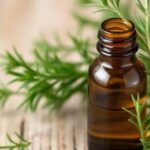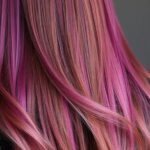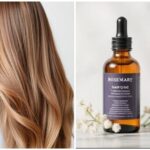Discover the best lightweight hair growth oils for oily scalp types! Say goodbye to greasy buildup and hello to thicker, healthier hair with these dermatologist-recommended, non-greasy oils.
If you have an oily scalp, putting on hair oil sounds like a terrible idea
You may be thinking, “I don’t want any more grease on this scalp, I already have to deal with excess sebum.” However, the reality is that the right hair oil serves to balance your scalp, boost hair growth and decrease greasiness over time. It’s important to know what lightweight oils, and non-comedogenic oils can help nourish the scalp, without adding any extra weight or clogging the pores.
In this guide, we will cover some of the best hair growth oils for oily scalp, how to use hair oils, some tips from experts on how to prevent build-up and what to look for (and avoid) within the ingredient label. Whether you see thinning hair, some breakage, or just want to find solutions to boost hair growth, these solutions are lightweight in nature (literally!).
Why Hair Oil is Important (Even if You Have an Oily Scalp)
Usually, people with oily scalps stay away from hair oil altogether as they worry that it will lead to greasiness, acne, or build-up. But whilst it may seem like common sense:
An oily scalp does not necessarily mean a hydrated scalp and in some cases, this excessive oil is a result of your body over-producing oil to rectify an imbalance or dehydration.
Oils that replicate your scalp’s natural sebum are beneficial because they help normalize the level of oil produced by the scalp.
Oils that are full of essential fatty acids and antioxidants will activate sleeping hair follicles, stimulate blood flow, and help with inflammation.
Top Characteristics to Look For in Oils for Oily Cook

Before diving the best oils here are the characteristics you need:
Lightweight & Quick Absorbing: Non-greasy, no build up
Non-Comedogenic: No pore blockage or scalp acne
Balancing: Normalize sebum; rather than stimulating it
Stimulating: Help with exposure to dormant follicles
No Heavy Carriers: No mineral oil, coconut oil or silicones
1. Rosemary Oil – The Growth Stimulant
Why It’s Good:
Rosemary oil is hands down one of the most well-known hair growth stimulants. It increases circulation to the scalp, wakes up regular dormant follicles, and aids in prevent or reducing hair thinning—all while not allowing your scalp to become oily.
How to Use:
for use as growth booster you want to dilute this with a carrier oil such as jojoba or grapeseed oil/better yet combination of the two. apply a few drops either putting the oil directly on scalp or into your hand and massage to scalp and rinse after 30–60 minutes.
Optimal Use: 2-3x weekly and do not use overnight as long as you have oily scalp.
2. Jojoba Oil – The Sebum Mimic
Why It Works:
Jojoba oil is chemically similar to human body sebum. This tricks the scalp into reducing oil content. Jojoba oil is full of vitamins, mainly vitamin E and zinc.
How to Use:
Heat 1-2 teaspoons, apply directly to the scalp, and leave it on for 20-30 minutes before shampooing.
Best For:
Oily and acne-prone scalps. It will not clog the hair follicles nor build up.
3. Tea Tree Oil – The Clarifying Powerhouse
Why It Works:
Tea tree oil can be considered anti-bacterial, anti-fungal, and anti-inflammatory. It can eliminate dandruff and buildup while clearing out hair follicles. This makes it ideal for oily scalps that are prone to itching or acne.
How to Use:
Always dilute (e.g. 3-4 drops of tea tree oil to 2 tbsp of a lightweight carrier oil), and utilize as a once-a-week scalp treatment.
Warning: Do not use it daily. Overusing will dry and irritate your scalp.
4. Grapeseed Oil – The Lightweight Champion
Why It Works
This oil is very light, provides antioxidants, and contains linoleic acid, which alleviates inflammation and helps regulate sebum. It can strengthen weak hair and will keep moisture locked in without being greasy.
How To Use It
Just a few drops can be placed onto the scalp or can be joined with rosemary or tea tree oil to boost scalp benefits.
Best For
Daily or frequent use on oily scalps requiring improved strength and softness.
5. Peppermint Oil – The Cooling Growth Booster
Why It Works
Peppermint oil improves circulation, leading to faster and thicker hair growth. The cooling sensation also provides relief to irritated, oily scalps.
How To Use It
Mix 3 drops with 1 tbsp of grapeseed or jojoba oil, massage into the scalp and rinse out after 20 minutes.
Pro Tip: Always spot test first; this oil can feel intense on sensitive skin.
6. Argan Oil – The Nourisher (in moderation)
Why It Works
Argan oil is filled with fatty acids and vitamin e to improve hair strength and control frizz. Argan oil is a bit heavier, but even oily scalps react well to a small amount of oil when the oil is used on the scalp (or just on the ends).
How To Use It
Apply just 2-3 drops onto the scalp, or just use on ends as a leave-in.
Oils to Avoid on Oily Scalps
Some popular oils are simply too heavy for oily scalps. The oils listed below are too heavy for oily scalps, will clog your pores, will trap dirt and contribute to the grease:
Coconut Oil: Very comedogenic and difficult to rinse out.
Castor Oil: Perfect for lashes or brows, but too thick for oily scalps.
Mineral Oil: Provides zero nutritional value to hair and can clog follicles.
Olive Oil: Healthy fat, but heavy and very difficult to remove.
Best Store Bought Hair Growth Oils for Oily Scalp (In 2025)
1. The Ordinary Multi-Peptide Serum for Hair Density
Light and water based, and not oily for hair growth.
The serum is very light and you can use it daily. There is no oily residue on your hair or scalp!
2. Mielle Rosemary Mint Scalp & Hair Strengthening Oil
Made with rosemary mint and biotin
Dilute and apply to scalp around 2-3x/week for best results.
3. Earth Rhythm Scalp Potion – India
Ensures oily scalp with dandruff, and helps hair regrowth.
Made with witch hazel and rosemary.
4. WOW Skin Science Onion Black Seed Hair Oil
Very light, not sticky, but contains drenching oil to your scalp.
Use it once or twice a week, away from your shampoo.
How to Apply Hair Oil on An Oily Scalp without Getting A Greasy Mess
Step 1: Clean Scalp First
Make sure your scalp is clean (after washing your hair or at mid-week if you feel the need to re-oil). Do not apply oil to a dirty head of hair—the oil will trap all the dirt and only make it worse.
Step 2: Target the Scalp Not the Length of your Hair
Remember, you are applying oil to your hair follicles, not your hair shaft. You only need 2-3 teaspoons of oil for the scalp for an oily scalp.
Step 3: Apply Light Pressure
When you massage the oil in, use your fingertips and not your nails. Spend about 5-10 minutes massaging the oil to stimulate blood flow to your scalp.
Step 4: Leave Oil on Hair for a Short Time
Based on your scalp type and the length of your hair, you only need to leave the oil on for 20–45 minutes. Overnight oiling on an oily scalp may leave the hair over-saturated from oil.
Step 5: Wash out Oil using a Gentle Shampoo
You will want to make sure you use a sulfate-free & paraben-free cleanser to wash out the oil. You want a shampoo that will cut through the oil without stripping the hair of all of it’s natural moisture.
DIY Oil for Oily Scalp
Here is an easy-to-make oil blend that will not clog up your hair follicles:
Ingredients:
- 2 tbsp Jojoba oil
- 1 tbsp Grapeseed oil
- 5 drops Rosemary Oil
- 3 drops Peppermint Oil
- 2 drops Tea tree oil
Instructions:
Combine all ingredients into a dropper bottle (a dark glass dropper bottle is preferred).
Apply 1-2 dropperfuls to your scalp and massage into the scalp.
Leave oil on for approximately 30 minutes.
Wash out using a mild shampoo.
Use 2x a week for best results.
Mistakes when hair oiling (in particular for oily scalp)
Picking heavy oils such as coconut oil, or castor oil.
Letting oil sit overnight – as a habit
Putting oil on a dirty scalp
Using too much
Not washing properly after oiling
Lifestyle Practices that Can Help your scalp health
Manage Stress: hormones that come from stress spur oil production and hair loss
Eat Balanced: your hair needs zinc, biotin and omega 3 to grow healthy hair
Shampoos: don’t over wash – but do wash after a workout, or after being sweaty
Make sure to continue to drink enough water?! sometimes the body reads oiliness as a sign to hydrate.
Final Thought’s
You can use hair oiling even if you have an oily scalp but need to be smart and strategic. The right oils can promote growth, decrease excess sebum and enhance hair health without heavy and greasy.
Lightweight fast absorbing oils like rosemary, jojoba, grapeseed, and peppermint can provide follicles what they need while your scalp gets fresh and clean. Take care of with purpose consistently to make your oily scalp an ally for your hair growth.
FAQs
Q1. How often should I oil my oily scalp?
2-3 times per week max. Focus on shorter treatments.
Q2. Will oiling my hair make it fall out more?
Not if you’re using the right oil. But, hair fall can increase if you use a heavy oil, or leave it on for too long.
Q3. Is coconut oil bad for oily scalp?
Yes. It is comedogenic and can clog pores and increase greasiness.
Q4. Which oils help with hair growth the fastest?
Rosemary and peppermint oil are top performers, especially when you incorporate an occasional scalp massage.
Q5. Should I oil after shampooing and conditioning?
Only use lightweight oils like argan or jojoba after shampooing, and as a leave-in. But if you’re oiling your scalp, keep it on there before shampooing.












